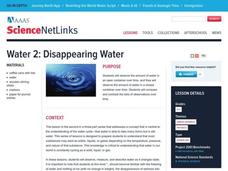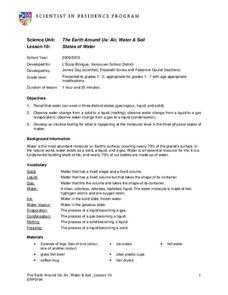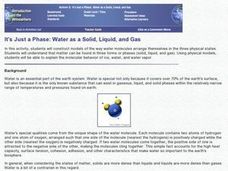Curated OER
Disappearing Water
Learners explore the water cycle. In this earth science lesson, students observe and measure water in a closed container and in an open container. Learners record their observations and compare their sets of data to draw conclusions...
Curated OER
Homeostasis and the Plasma Membrane
In this homeostasis and plasma membrane worksheet, students complete 4 different questions related to the diagram shown at the top of the sheet. They draw an arrow across the plasma membrane in the diagram to show which way water...
Curated OER
The Chemistry of Life
In this molecule worksheet, students will use a diagram of a water molecule to see how many electrons and protons the molecule has and use a glycerol molecule diagram to discover carbon atom bonds. 5 fill-in-the-blank questions.
Curated OER
Water - the (Nearly) Universal Solvent
In this water worksheet, high schoolers explore the reasons why water is considered a universal solvent. Students compare different ways to change the dissolving rate of a solute. This worksheet has 11 fill in the blank and 8 matching...
Curated OER
Counting Atoms in a Molecule
In this counting atoms in a molecule worksheet, students read about the molecule propanal that was discovered by the giant radio telescope in the Milky Way Galaxy. Students solve 6 problems where they find the number of atoms in the...
Curated OER
The Cool Forms of Water
Students discover the different forms of water on Earth. In this states of water lesson, students read material on the different forms of water and how they are created. The students answer written questions on worksheets.
Curated OER
States of Water
Students investigate the 3 states of matter. In this physical science "matter" lesson, students observe and participate in a number of demonstrations involving melting and freezing water. Students observe the effect heat has on changing...
Curated OER
The Water Cycle
Students list the nine places on earth where water is found. They define the terms cycle and water cycle. Students explain how energy from the sun powers the movement of water molecules through the water cycle. They name and describe...
Curated OER
Water String Travels
Young scholars examine the properties of water and conduct experiments demonstrating adhesion. Using a wet string, they observe water moving by adhesion from a beaker full of water to an empty one. They draw cartoons of water molecules...
Concord Consortium
Chain Reaction Between Hydrogen and Oxygen
Looking for a simple way to teach conservation of energy in chemical reactions? Pupils can observe energy changes as water forms during a chain reaction between oxygen and hydrogen using an interactive. The resource instructs users to...
Scholastic
What Are Clouds Made Of?
Tiny bubbles, in my...clouds? Offer youngsters a hands-on, visual learning experience when reviewing the scientific concepts of condensation, water vapor, and the collection of droplets that make up clouds.
Teach Engineering
Balancing Liquid on a Coin: How Intermolecular Forces Work
Let knowledge of chemistry flow like water. Future scientists conduct two different experiments to investigate the properties of water. They learn about surface tension and cohesion as they see how many drops of water they can place on a...
Curated OER
How Big is a Molecule?
Students calculate the size of a molecule. In this molecules and their sizes lesson plan, students find the size of an oleic acid molecule by using a measured amount of drops of oleic acid to find the volume of the sample, the thickness...
Curated OER
Molecules, Moles and Molar Masses
In this molecules, moles and molar masses learning exercise, students find the atomic masses of 8 elements, they write the formulas for 6 diagrams of molecules and they find the molecular masses of 12 compounds. Students also find the...
Curated OER
Call Me Bond, Hydrogen Bond
As amazing as James Bond is, the surface tension of water does not allow him to walk on it! In this series of little lab activities, physical scientists play with the properties of water due to the hydrogen bonds and resulting polarity....
Curated OER
It's Just a Phase: Water as Solid, Liquid and Gas
Students construct models of the way water molecules arrange themselves in three physical states - solid, liquid, and gas. They explain the molecular behavior of ice, water, and water vapor.
Curated OER
Observation Milk Fat Lesson
Turn your class loose to experiment with the different fat content in skim milk, whole milk, half and half, and heavy cream. This is a visually vibrant experiment, as learners drip food coloring on the surface of the products and measure...
Concord Consortium
Polar and Non-Polar Interface
Why is there so much frozen water at Earth's poles? Because water is a polar molecule! Young scientists observe polar molecules moving in a mixture of oil and water. They see the changes in potential energy in the hydrophilic and...
Curated OER
Molecules on the move
In this molecules worksheet, students add food coloring to water and heat it up and answer questions about their findings. Students answer 4 questions about heating molecules.
American Chemical Society
Heat, Temperature, and Conduction
How does heat move from one item to another, even when the items are in different states of matter? Pupils experiment with adding washers to hot water and adding hot washers to room temperature water to observe the heat transfer.
American Chemical Society
Temperature Affects Density
Different substances can have different densities, but can the same substance have different densities? Lesson explores the effect of temperature on the density of water. Extension idea connects the concept of how melting ice in lakes...
American Chemical Society
Changing State: Condensation
When you have a cold drink and you notice the water forming on the outside, it is literally pulling the water from the surrounding air to form the condensation. After watching a demonstration of condensation forming on a glass,...
American Chemical Society
Can Gases Dissolve in Water?
Why does soda fizz when opened? Learners discuss the appearance of bubbles in soda bottles when opened. In groups, they design and complete an experiment comparing the amount of carbon dioxide dissolving in cold versus hot liquids.
Curated OER
Crazy Chemistry Lesson Plan
Students study water molecules, cohesion and surface tension. In this molecule cohesion lesson students create chemical reactions that cause a balloon to inflate and another one that results in soap suds.
Other popular searches
- Polar Water Molecules
- Water Molecules Models
- Constructing Water Molecules
- Matter and Molecules Water
- Water Molecules Definitions

























